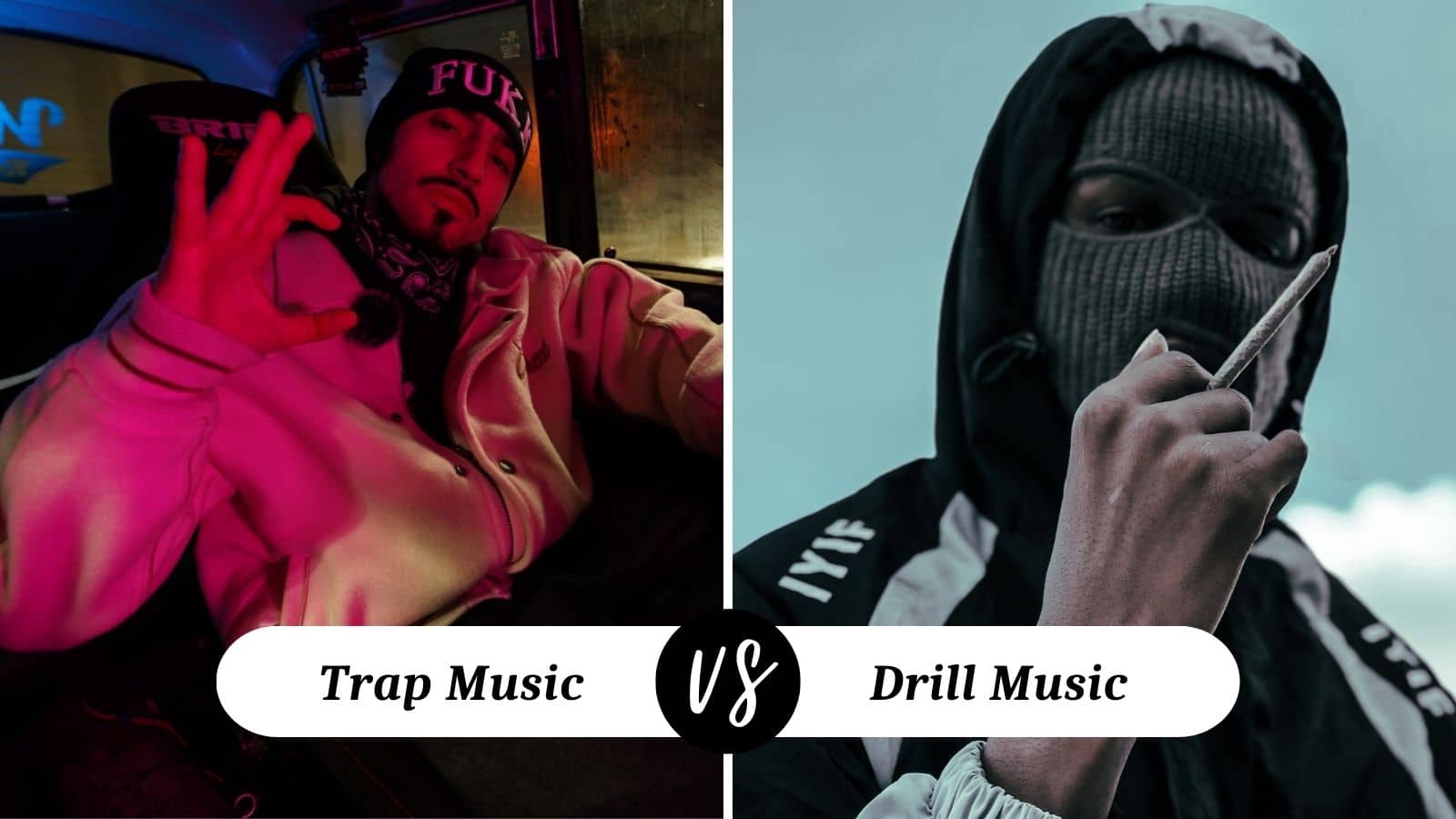
Both trap music and drill music are sub-genres within the hip-hop landscape, but drill can be seen as a sub-genre of trap music. We’ll investigate these two subgenres and point out their similarities and differences.
Drill Music vs Trap Music
| Trap Music | Drill Music | |
|---|---|---|
| Beat | 130—140 BPM | 60—70 BM (tempo can vary widely) |
| Lyric Delivery | Flowing lyrics, often use the Migos (triplet) flow Flowery language, metaphors | Cold, nihilistic, deadpan, almost no emotion Monotonous delivery—artists are commenting on the daily life in Chicago where gang violence was rife and daily occurrence Almost minimalist lyrics, lyrics are plain and tells stories in real terms Lyrically like gangsta rap |
| Sample Lyrics | “Ain’t running out of money Bitch we running out of opps” | “Sluggah got hit up in the party he did a dance Sizzlac dead and they don’t post him on the ‘gram” |
| Thematic Material | Deals with selling drugs (trap is slang for trapping or traphouse where drugs are bought and sold) Rising to wealth, fame, and lavish lifestyles Doesn’t mention who lyrics are aimed at | Deals with life and hardships on the street About shooting (drill is slang for shooting someone) Comments on the violent life in Chicago Mentions rivals by name |
| Instrumentation | 808 kick Rolling hi-hats and snare Heavy bassline | 808 kick Auto-tune is used to give the music an emotionless quality |
| Origin Year | 1990s | 2010s |
| Origin City | Atlanta, Georgia | Chicago (Dro City), Illinois |
Trap Music: Where It All Started
One could say there’s a north-south axis between trap and drill music—Chicago in the north with Atlanta in the south. So, let’s start with trap music.
References to drugs in hip-hop music aren’t a new phenomenon. It goes back to the 1980s with Grandmaster Flash & Melle Mel’s 1983 hit White Lines (Don’t Don’t Do It).
The references to taking cocaine and sexual activities are explicit. Still, the disparity between the treatment of racial groups is also addressed in the lyrics:
A street kid gets arrested, gonna do some time
He got out three years from now just to commit more crime
A businessman is caught with 24 kilos
He’s out on bail and out of jail
And that’s the way it goes, raah!
Arriving in the 1990s, UGK’s hit, Pocket full of Stones (1992), wasn’t considered part of the trap music genre yet.
However, in retrospect, we can see that this song gives many of the features associated with trap music: halt-time beats that feel slower and faster simultaneously, 808-based kick drum, telling stories about drug deals, and an overall woozy feeling.
Around the early 2000s, trap music was a significant trend in the Southern hip-hop scene and became acknowledged as part of the mainstream hip-hop genre. T.I. is credited for coining the term ‘trap music’ with his album Trap Muzik.
However, young Jeezy was trap music’s first mainstream breakout star two years later when his 2005 debut album Let’s Get It: Thug Motivation 101 went platinum within a month after its release.
In the 2010s, trap music started merging with the US’s commercial EDM scene. Things became confusing because EDM is a type of dance music featuring beats of around 200 BPM.
Producers such as TNGHT and Baauer referred to their EDM productions as trap music as well—suddenly, two distinct music movements shared the same name. But all was not lost. EDM helped to popularize trap music and made it more influential.
This resulted in a symbiotic relationship where trap music can also be heard in pop music: Rihanna’s Pour it Up, Lil Nas X’s country-trap hit Old Town Road crosses trap with country music, and the trap influences can also be heard in Ariana Grande’s Sweetener album.
Drill Emerges from Trap Music
Meanwhile, in Chicago, drill music started to emerge around the early 2010s. Drill music shares some commonalities with trap music: the 808 kick is still present, but the snare drums and hi-hats are sparsely used, the half-time feel is still present, and the lyrics still deal with the harsh realities of life in the city.
Atlanta’s trap music did not only influence pop music but also found a footing in drill music.
Apart from the trap influence, drill music also draws from its environment, notably Chicago’s South Side neighborhoods. The government’s apathy towards the communities living in those neighborhoods.
A case in point is PacMan, a drill rapper and native of Dro City in Chicago whose life was cut short by violence. His 2010 single, It’s a Drill, is regarded as one of the ‘template’ songs that laid the foundation for drill music.
Instead of using metaphors and somewhat softening the subject matter, drill artists deliver their lyrics in an honest, deadpan manner. They candidly speak about life’s hardships, social issues, and gang issues.
However, because the music is so violent in its content, people are scared that the lyrics are inciting gang violence. During an interview with HipHopDX, Young Chop clearly stated:
I don’t even know what Drill music is, but whatever they think it is we just telling the truth. Everything in the raps is the truth of what’s going on in the streets of Chicago right now. So whatever they portray it is, that’s what it is to them. I can’t change nobody way of thinking.
Drill rappers are expressing what is around them. They are showing the world their lived experiences. Some say this leads to violence, while others argue it is artistic freedom to express yourself.
Conclusion
Trap may be seen as the parent genre for drill music, but it has evolved into many different directions influencing even pop music. Drill, on the other hand, is still regarded as a safety concern because politicians and policymakers fear it incites violence.
Trevor Noah provides an interesting view of the problems drill music poses. However, the problem should rather be addressed by governments and city leaders instead of blaming artists for calling attention to what really goes on.

